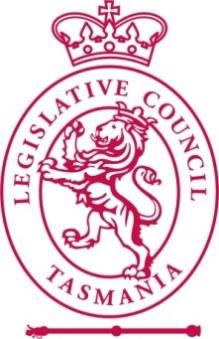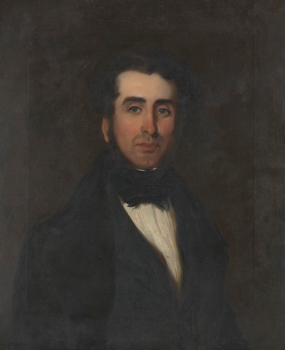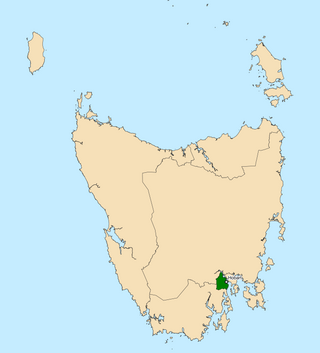Related Research Articles

The Tasmanian Legislative Council is the upper house of the Parliament of Tasmania in Australia. It is one of the two chambers of the Parliament, the other being the House of Assembly. Both houses sit in Parliament House in the state capital, Hobart. Members of the Legislative Council are often referred to as MLCs.

The Parliament of Tasmania is the bicameral legislature of the Australian state of Tasmania. It follows a Westminster-derived parliamentary system and consists of the governor of Tasmania, the Tasmanian House of Assembly, and Tasmanian Legislative Council. Since 1841, both Houses have met in Parliament House, Hobart. The Parliament of Tasmania first met in 1856.

Bracknell is a rural locality and town in the local government areas of Meander Valley and Northern Midlands in the Launceston and Central regions of Tasmania. The locality is about 22 kilometres (14 mi) south-east of the town of Westbury. The 2016 census has a population of 459 for the state suburb of Bracknell.

The electoral division of Paterson was one of the 15 electorates or 'seats' in the Tasmanian Legislative Council from 1999 to 2008 when a redistribution saw it reverted to its original name of Launceston.

The electoral division of Rumney is one of the 15 electoral divisions in the Tasmanian Legislative Council. The division is located in Southern Tasmania to the east of the division of Pembroke.

The electoral division of Derwent is one of the 15 electoral divisions in the Tasmanian Legislative Council. It is situated in the central south of the state.

The electoral division of Nelson is a constituency of the Tasmanian Legislative Council. The division includes many of the suburbs to the south of Hobart, including South Hobart, Sandy Bay, Taroona and Kingston. The division was created in 1999 when the electoral division of Queenborough was renamed in a review of electoral boundaries. The member from 1999 until his retirement in 2019 was independent Jim Wilkinson.

The Electoral division of Huon is one of the 15 electoral divisions in the Tasmanian Legislative Council. It was created in 1999, however similar electorates of this name have existed since 1900, and members of the Tasmanian upper house for this region appear to have been elected since 1856.

The Tasmanian Legislative Council has fifteen single member constituencies, called divisions.

The electoral division of Mersey is one of the fifteen constituencies in the Tasmanian Legislative Council. The division covers an area of 732 km2.

The electoral division of Montgomery is one of the fifteen electorates in the Tasmanian Legislative Council.

The electoral division of Launceston is one of 15 electorates or seats in the Tasmanian Legislative Council, created in 2008. It also previously existed until 1999, when it was abolished and substantially incorporated into the new division of Paterson, which was in turn abolished in 2008.

The electoral division of Elwick is one of the 15 electoral divisions in the Tasmanian Legislative Council. The division covers most of the municipality of Glenorchy.

The electoral division of Hobart is one of the 15 electoral divisions in the Tasmanian Legislative Council. It was originally created in 1856 when the Council became the upper house of the Parliament of Tasmania. The seat was abolished in 1999 and re-created in 2008 after a redistribution saw the former division of Wellington returned to its former name.
The Electoral division of North Esk was an electoral division in the Tasmanian Legislative Council of Australia. It existed from 1855 to 1901, when it was abolished.
James Reid Scott was an explorer and colonial Tasmanian politician, member of the Tasmanian House of Assembly and later the Tasmanian Legislative Council, he was also Colonial Secretary of Tasmania.

Robert Quayle Kermode was a British politician. He was a member of the Tasmanian Legislative Council and the Tasmanian House of Assembly in the 1850s and 1860s. In 1852 Godfrey Mundy claimed Kermode to be the richest Manxman in the world, in his book Our Antipodes. Kermode's mansion, Mona Vale, itself was at the time the largest house in Australia.

The electoral division of McIntyre is one of the fifteen electorates in the Tasmanian Legislative Council, it includes Flinders Island, the northern east coast of Tasmania, and regional areas south and west of Launceston. It is named after Margaret McIntyre, who was the first woman to be elected into the Parliament of Tasmania in 1948.

The electoral division of Prosser is one of the fifteen electorates in the Tasmanian Legislative Council, it includes the south-east coast of Tasmania, the Sorell township and the Tasman Peninsula. Prosser is named after the Prosser River, which flows through the centre of the division.

The electoral division of Clark is one of the five electorates in the Tasmanian House of Assembly, it is located in Hobart on the western shore of the River Derwent and includes the suburbs below Mount Wellington. Clark is named after Andrew Inglis Clark, a Tasmanian jurist who was the principal author of the Australian Constitution. The electorate shares its name and boundaries with the federal division of Clark.